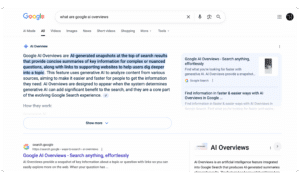Zero-Click Searches Explained: How to Drive Brand Visibility Without Clicks

What Are Zero-Click Searches, and Why Does It Matter?
A zero-click search happens when someone gets what they need directly from the search results page without ever clicking through to a website. Instead of visiting a brand’s site, the user finds the answer inside Google’s own features: AI Overviews, Featured Snippets, Knowledge Panels, or People Also Ask boxes. In these situations, the searcher still gets their information, but the click, and the chance to bring them onto your site, is no longer necessary.

This change in search behavior is no small shift. In 2025, nearly 60% of global searches end without a click. At first glance, this might seem like a traffic problem. In reality, it’s about visibility and the chance to stand out. For brands, that means attention doesn’t always require a media buy. It’s earned by showing up in the answers that matter most.
Why Zero-Click Visibility Is a Brand Asset
Authority Without the Click
When your brand appears as the answer, it earns instant credibility. Zero-click placements sit above both ads and organic results, making them the first thing people notice. Even without a click, the impression and perception of authority lasts.
Driving Future Action
Zero-click exposure builds recognition. When people repeatedly see your brand in answer boxes, it creates familiarity. Over time, that recognition translates into more branded searches, direct visits, and higher-intent conversions later in the funnel.
Measuring What Matters
Success in SEO used to be defined by clicks. But in a zero-click landscape, clicks alone no longer tell the full story. That shift requires looking at different signals of performance. Instead of asking “how many people came to our site?” the better question is “where is our brand showing up, and how is that visibility driving recognition and conversion later?”
Here’s what to track instead of clicks:
Visibility Where People Get Answers
What to track:
- Search impressions: Track growth trends over time for priority keywords. Are you showing up more often, and is visibility increasing where it matters?
Share of SERP features: Track both ownership (%) and changes. If you own 30% of featured snippets today, is that improving month over month—or are competitors taking ground? - Branded video placements: Track the frequency and share of your owned content in SERPs (video carousels, AI Overviews, featured clips). The key question isn’t just “are you there?” but “are you there more often, and more than others?”
Why it matters: If you’re not visible in the places people look first, you’re not part of the conversation.
Recognition That Drives Action
What to track:
- Branded search growth: Are searches for your brand increasing over time?
- Direct traffic lifts: Is more traffic coming straight to your site without a referring channel?
- Returning visitor share: Are more people coming back after first exposure?
- Brand recall surveys: Are recall scores improving alongside zero-click exposure?
Why it matters: Consistent exposure builds familiarity. Familiarity turns into preference, and preference drives higher intent.
Momentum Across the Funnel
What to track:
- Assisted conversions: Are zero-click exposures influencing conversions later in the funnel?
- Conversion rate on branded queries: Is CVR improving as familiarity builds?
- Time to purchase: Is the decision cycle shortening as trust builds earlier?
- Post-click engagement: Once users do visit, are they engaging more deeply?
Why it matters: Early visibility builds trust. That trust reduces friction in the decision process and shows up later as stronger conversion performance.
The Rise of YouTube in AI Overviews
Video is now at the center of zero-click visibility. Since January 2025, YouTube citations in Google AI Overviews have increased by more than 25%, with the strongest growth in instructional content, product demos, and comparison searches. Google is clearly prioritizing YouTube, especially in ecommerce and tech. Instead of surfacing product pages or spec sheets, it highlights unboxings, reviews, and demo videos.
For fact-based searches, Google still leans on text. Wikipedia, major publishers, and authoritative blogs remain the default sources for definitions, research, and background information. But for “show me how” or “prove it works” queries, video dominates. And because YouTube clips often appear above ads, they shape perception before paid or organic links even enter the picture.
How To Optimize for Zero-Click Visibility
Optimizing for zero-click is about making sure your brand shows up as the answer. That requires structuring content so Google can easily pull it into features like AI Overviews, snippets, and video carousels.
- Write direct answers on your site that can win Featured Snippets. Place them in blog posts, FAQs, and resource pages where users naturally look for definitions or quick explanations.
- Add schema markup to your web pages so Google can surface rich results like reviews, FAQs, and product details.
Use natural, question-based language in your content to mirror how people search, making it easier for Google to match queries. - Optimize your YouTube videos—including titles, transcripts, and timestamps—so they’re easy for AI to parse.
- Keep brand information consistent across sources like Wikipedia, social profiles, and third-party citations so Google recognizes one authoritative version of your brand.
WITHIN’s POV
At WITHIN, we know SEO today isn’t just about capturing clicks, it’s about showing up where people find answers first. That means creating content in the formats users expect, auditing competitor visibility in snippets, videos, and AI Overviews, and expanding strategies to include YouTube and affiliates as Google pulls more from those sources. Most importantly, it means tying zero-click presence to real business outcomes.
We’re not just optimizing for search. We’re optimizing for the search experience, ensuring your brand is the first credible answer users see. And in today’s landscape, visibility isn’t about being the last stop. It’s about being the first one they see.
Let’s Chat
Authors
Christina Hatzipanagiotis, Search Engine Optimization Manager
Britnee Howard, Search Engine Optimization Manager